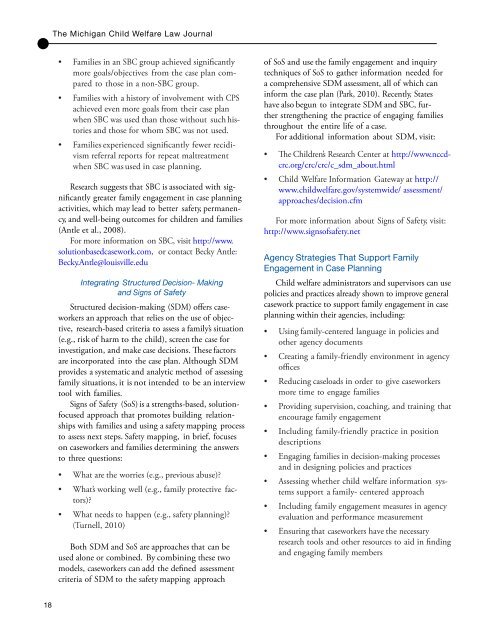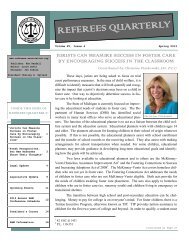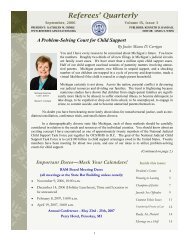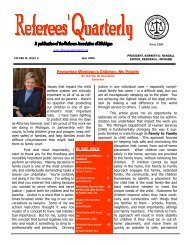The Michigan Child Welfare Law Journal - Referees Association of ...
The Michigan Child Welfare Law Journal - Referees Association of ...
The Michigan Child Welfare Law Journal - Referees Association of ...
Create successful ePaper yourself
Turn your PDF publications into a flip-book with our unique Google optimized e-Paper software.
•<br />
<strong>The</strong> <strong>Michigan</strong> <strong>Child</strong> <strong>Welfare</strong> <strong>Law</strong> <strong>Journal</strong><br />
• Families in an SBC group achieved significantly<br />
more goals/objectives from the case plan compared<br />
to those in a non-SBC group.<br />
• Families with a history <strong>of</strong> involvement with CPS<br />
achieved even more goals from their case plan<br />
when SBC was used than those without such histories<br />
and those for whom SBC was not used.<br />
• Families experienced significantly fewer recidivism<br />
referral reports for repeat maltreatment<br />
when SBC was used in case planning.<br />
Research suggests that SBC is associated with significantly<br />
greater family engagement in case planning<br />
activities, which may lead to better safety, permanency,<br />
and well-being outcomes for children and families<br />
(Antle et al., 2008).<br />
For more information on SBC, visit http://www.<br />
solutionbasedcasework.com, or contact Becky Antle:<br />
Becky.Antle@louisville.edu<br />
Integrating Structured Decision- Making<br />
and Signs <strong>of</strong> Safety<br />
Structured decision-making (SDM) <strong>of</strong>fers caseworkers<br />
an approach that relies on the use <strong>of</strong> objective,<br />
research-based criteria to assess a family’s situation<br />
(e.g., risk <strong>of</strong> harm to the child), screen the case for<br />
investigation, and make case decisions. <strong>The</strong>se factors<br />
are incorporated into the case plan. Although SDM<br />
provides a systematic and analytic method <strong>of</strong> assessing<br />
family situations, it is not intended to be an interview<br />
tool with families.<br />
Signs <strong>of</strong> Safety (SoS) is a strengths-based, solutionfocused<br />
approach that promotes building relationships<br />
with families and using a safety mapping process<br />
to assess next steps. Safety mapping, in brief, focuses<br />
on caseworkers and families determining the answers<br />
to three questions:<br />
• What are the worries (e.g., previous abuse)?<br />
• What’s working well (e.g., family protective factors)?<br />
• What needs to happen (e.g., safety planning)?<br />
(Turnell, 2010)<br />
Both SDM and SoS are approaches that can be<br />
used alone or combined. By combining these two<br />
models, caseworkers can add the defined assessment<br />
criteria <strong>of</strong> SDM to the safety mapping approach<br />
<strong>of</strong> SoS and use the family engagement and inquiry<br />
techniques <strong>of</strong> SoS to gather information needed for<br />
a comprehensive SDM assessment, all <strong>of</strong> which can<br />
inform the case plan (Park, 2010). Recently, States<br />
have also begun to integrate SDM and SBC, further<br />
strengthening the practice <strong>of</strong> engaging families<br />
throughout the entire life <strong>of</strong> a case.<br />
For additional information about SDM, visit:<br />
• <strong>The</strong> <strong>Child</strong>ren’s Research Center at http://www.nccdcrc.org/crc/crc/c_sdm_about.html<br />
• <strong>Child</strong> <strong>Welfare</strong> Information Gateway at http://<br />
www.childwelfare.gov/systemwide/ assessment/<br />
approaches/decision.cfm<br />
For more information about Signs <strong>of</strong> Safety, visit:<br />
http://www.signs<strong>of</strong>safety.net<br />
Agency Strategies That Support Family<br />
Engagement in Case Planning<br />
<strong>Child</strong> welfare administrators and supervisors can use<br />
policies and practices already shown to improve general<br />
casework practice to support family engagement in case<br />
planning within their agencies, including:<br />
• Using family-centered language in policies and<br />
other agency documents<br />
• Creating a family-friendly environment in agency<br />
<strong>of</strong>fices<br />
• Reducing caseloads in order to give caseworkers<br />
more time to engage families<br />
• Providing supervision, coaching, and training that<br />
encourage family engagement<br />
• Including family-friendly practice in position<br />
descriptions<br />
• Engaging families in decision-making processes<br />
and in designing policies and practices<br />
• Assessing whether child welfare information systems<br />
support a family- centered approach<br />
• Including family engagement measures in agency<br />
evaluation and performance measurement<br />
• Ensuring that caseworkers have the necessary<br />
research tools and other resources to aid in finding<br />
and engaging family members<br />
18







